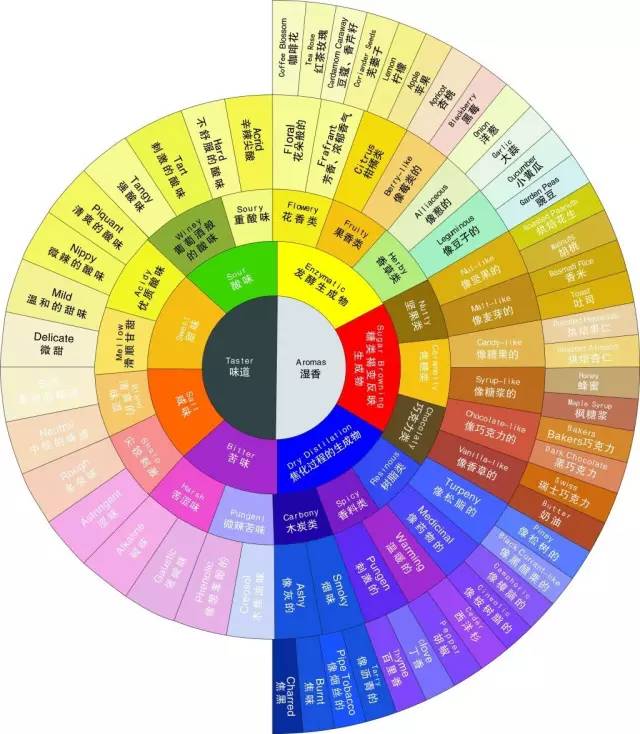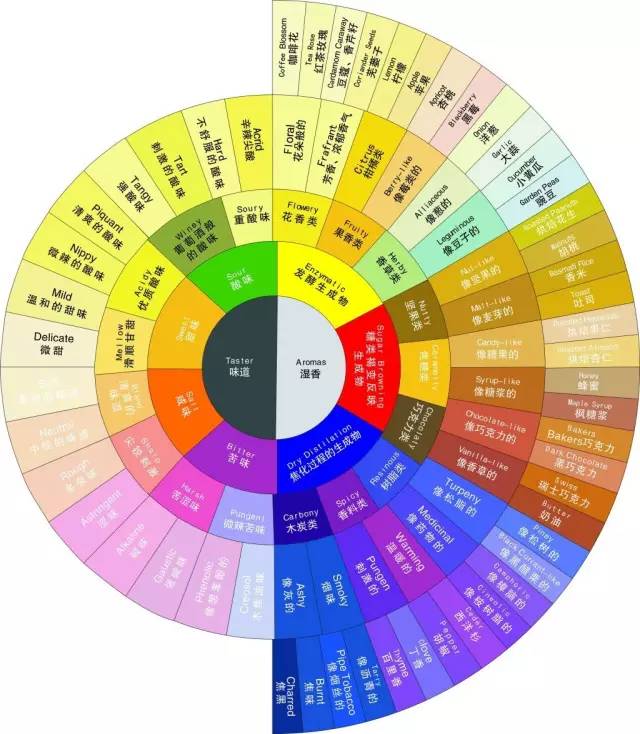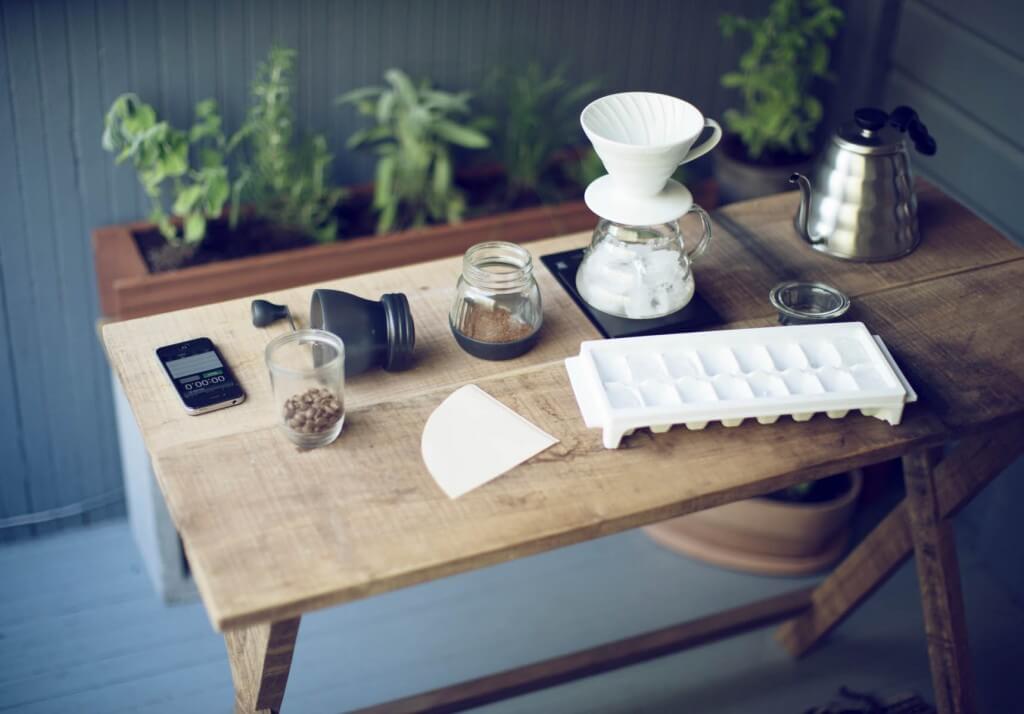Coffee flavor wheel: bitter and salty, sour and sweet
Follow the caf é (Wechat official account vdailycom) and found that Beautiful Cafe opened a small shop of its own.
Coffee only has four kinds of water-soluble taste: sour, sweet, bitter and salty. Therefore, the "taste spectrum" is not as complicated as the "smell spectrum" described in the previous chapter. Some sour and new flavor aromatics are only volatile and need to be identified by the sense of aversion; some are not volatile, but only water-soluble, which need to be identified by taste buds; and some silver acid ingredients are both volatile and water-soluble, so sour and new flavors often show the dual senses of hatred and taste.
As for bitterness and saltiness, they are not volatile and cannot be smelled with the nose, so they belong to the taste category of taste identification.
Let's go on to the previous section and start learning. Get ready, and here we go!

Chlorogenic acid increases bitterness and astringency.
Many people think that only deep baking or re-baking will be bitter, but in fact, the baking technology is poor, even the shallow baking before the second explosion will have a bitter taste. For example, if the baking time is too long and the throttle is closed or opened too small, the carbonized particles in the furnace cannot be discharged, the bean watch is recognized, or the smoke pipe has not been removed for too long, even the shallow baking will have a serious dry or bitter taste.
In addition, phenolic acid chlorogenic acid in the baking process, mostly will be degraded into quinic acid, caffeic acid chlorogenic acid lactone, these products will increase the bitterness of coffee, if there is too much chlorogenic acid residue, the astringency will increase, and even appear astringent bitterness. The chlorogenic acid content of Robasta is twice as high as that of Arabica, which is more bitter. The worst thing is that there are too many flawless beans, especially the unpicked black beans, which can be hard to swallow when baked in shallow water.
Caffeine tastes slightly bitter
The white powder of caffeine alkaloids tastes bitter, but its melting point is as high as 238 ℃, far exceeding the oven temperature of 190 ℃ ~ 230 ℃ of ordinary coffee, so caffeine is not damaged in the roasting process, whether light or re-roasted. The study also found that caffeine is not responsible for the bitterness of coffee. At best, caffeine accounts for 10% to 15% of the bitter taste of coffee, because the brewed coffee has been diluted and can be regarded as a slightly bitter taste.
The threshold concentration for the bitterness of caffeine to be drunk by the sense of taste is 200ppm (200mg/kg). You can't get the bitterness of caffeine unless you brew it a little stronger. Interestingly, although artificial decaf coffee contains only 0.03% trace caffeine, even cup testers can not tell how the bitterness of decaf coffee is different from that of normal coffee, which shows that caffeine is not the main cause of coffee bitterness.
The unexpected sweet and bitter taste of trigonelline
Trigonelline is an important factor in the bitterness of coffee. Fortunately, the deeper the degree of roasting, the more fenugreek, the lower the bitterness. According to reason, the degradation of fenugreek in shallow roasting is less than that in deep roasting, so the bitterness in shallow roasting is higher than that in deep baking. However, this is not the case in reality. The bitterness of shallow baking is significantly lower than that of deep baking. After the research, the scientists found that the bitterness of the original shallow and medium baked caramel, which had more residue, unexpectedly combined with the shallow medium baked caramel with lower carbonation and higher sweetness to produce a pleasant sweet and bitter taste.
On the contrary, although the deep-baked trigonelline has been degraded completely and has little bitterness, the deep-baked caramel has a higher degree of carbonization and higher bitterness (but not absolutely), which counteracts the non-bitterness after the degradation of fenugreek. It can be seen that fenugreek base and caramel have a place in the balance between shallow baking and deep baking.
●●●
Shallow medium baking taste spectrum sweetness spectrum: sweet and sour and sweet
Sweet and sour: | Fruit | both sweet and sour | Sweet and sour |
Qingtian: | Sangshun I is sweet and salty neutralizes | Black sugar tail rhyme I is sunny. | washing beans with water from the middle of the sea.
Among the four major water-soluble flavors of coffee, sweet ignorance is the most, accounting for 39% of the soluble substances. Sucrose, ethanol, Glycols and amino acids in raw beans are concentrated into many sweet substances after baked caramelization and Mena reaction, among which caramel and aran compounds are the main sources of coffee sweetness.
Although the volatile aroma of caramel is easy to enjoy with the technique of returning air to the nose and the sense of smell behind the nose, it is not easy for the taste to drink the sweetness of black coffee, because the sweetness is often disturbed by other sour, bitter and salty ingredients, and it is not easy to jump out. Unless the sweet ingredients of ripe beans are higher than the average, it is possible to break out and drink sweet taste. In other words, smell is far more likely to enjoy the sweetness of coffee than taste.
Sweet and sour complement each other and sweeten
Therefore, the cup test attaches great importance to the interaction between sugar and sour and salty taste in the taste part. The sour and sweet taste of the shallow and medium roasted "sweet spectrum" is the interactive taste of sweetness and sour taste, which most often appears in the water-washed beans above 1300 meters above sea level. If the content of citric acid, malic acid and acetic acid is not low, it will have a sharp sour taste, but if the sugar content of the coffee is high, it can neutralize some of the fruit acidity, making the acidity supple, dynamic, and fruit flavor, and there is an interesting "sour and sweet shock" taste.
When the sour and sweet coffee is cooled, it is easy to have the sweetness and aroma of black sugar or caramel. Although the best warm temperature for coffee is 85 ℃, connoisseurs will drink from medium to high temperature to room temperature, experiencing the sweet shock of Arabica acid at high altitude.
Salty and sweet increase each other's sweetness
The sweetness of shallow medium culture "sweetness" mainly refers to the sweetness of dried beans. The fatty acid content treated by the sun is low, and the salty ingredients contained in minerals are easy to interact with sugar to produce a sweet taste. However, if the sugar content of dried beans is lower than the average quality, it is easy to produce salty taste. In addition, sweet taste is also common in washed beans or semi-washed beans below 1300 above sea level. Indonesia and Taiwan, as well as the Blue Mountains of Jamaica, often have this sweet feeling.
●●●
Shallow medium baking taste spectrum salty taste spectrum: slightly salty and thankless
Brackish: | shallow and medium baked | Woodiness | monotonous
Heavy salty: | Deep baking | throat bite | salty astringent | concentration is too high
It is easy to be salty without organic matter
Among the four tastes of coffee, the salty taste is less known, and some people even drink coffee for most of their lives without knowing that it will be salty. The salty taste of coffee comes from the minerals it contains, including chloride, bromide, iodide, nitrate, potassium sulfate, lithium sulfate, and inorganic substances such as sodium magnesium calcium.
These salty ingredients account for about 14% of the weight of soluble flavors in coffee (see chart 1). Although the salty taste of coffee is omnipresent, it is often masked by the interaction between sour and sweet. Once the black coffee is salty, the sour and sweet organic matter has been oxidized, causing the salty taste of inorganic matter to be highlighted, which can be regarded as a warning that the coffee is stale or stale.
Brazilian commercial bean flavor is poor and monotonous, mainly because the salty inorganic content is higher than the general origin, neutralizing organic acid and sugar, so drink empty, if the Brazilian bean sugar and organic acid content is too low, it is very salty taste. Indonesian beans are also often salty, which has something to do with lower altitude or more Arabica and Robasta hybrids. My shallow experience is that salty coffee is likely to smell like sawdust, which is also evidence of the lack of organic matter. Basically, the salty taste of shallow roasted coffee is much less obvious than that of re-cultivation.

Deep roasting to increase salinity
People who often drink Nanyi's re-roasted espresso should feel a lot of pain for the heavy salty coffee. They drink sweet coffee in the first five days after it comes out of the oven, but a week later, the salty taste goes wild and the sweeping product sips Yaxing. Why does deep-roasted coffee tend to be salty? This is not difficult to understand, because the fiber of the re-baked bean is softer, there are many honeycomb voids in the cell wall, the exhaust is also more prosperous, the organic matter is more easily taken away by the discharged carbon dioxide, and the oil seeps out from the bean surface to accelerate the oxidation process. In addition, the organic acid content of re-baked beans is much lower than that of shallow baked beans, so it is easy for salty ingredients to jump out and abuse flavor bacteria.
It can be said that the coffee rich in sour and sweet organic matter is enough to restrain the appearance of salty taste, but the content of organic matter is less, the roasting degree is deeper, the freshness is not enough, and even the brewing concentration is high, which often becomes the hotbed of salty coffee. As far as the cup test is concerned, sweetness is the most desirable, slight bitterness and tannic acid can also increase the richness of the taste spectrum, but salty taste is negative, even if slightly salty is not pleasing.
Re-baking taste spectrum, only technology is the question.
The above is the sour, sweet and bitter taste spectrum of shallow and medium baking before the second explosion. if you continue to bake, enter the deep baking in the middle of the second explosion, or even re-bake until the end of the second explosion, the coffee taste spectrum will change, the aliphatic acid will degrade, and the bright sour taste will disappear. carbonization and phenolic secondary degradation increased, bitterness aggravated, and the taste spectrum was simplified into three categories: "scorched bitterness", "heavy salty" and "glycol". Unfortunately, nine out of ten people in the coffee industry do not invite the way of deep baking and re-baking, and they enter the second stage of the second explosion, leaving almost only "scorched bitter" and "heavy salty" hindering the taste, causing the general public to have a great misunderstanding of re-baked beans, thinking that deep-baked beans are either scorched or bitter and useless. Fortunately, there are still a very small number of outstanding entrepreneurs who share the highest state of deep baking without bitterness and sweetness in the world.
Rich but not bitter, glycolic throat-moisturizing European-style re-baking, 1966 by Dutch-born Avery. Alfred Peet introduced to the United States and exported the re-roasting revolution to the United States with the San Francisco-based Peet's Coffee & Tea as the beachhead, emphasizing the concept of fresh baking in the store, reversing the bad habit of drinking stale canned coffee and igniting the half-century-long evolution of boutique coffee.
Although the re-baking fashion is a stunt of the "second wave" of boutique coffee, which has been gradually replaced by the rising "third wave" shallow baking fashion after the millennium, most coffee people in Taiwan still prefer the flavor that is not sour after the second explosion. Of course, it is not the low-quality deep-baked bitter and salty, but the high-quality deep-baked sweet throat rhyme, rising scorched fragrance and slightly choking alcohol smell that make them taste good.
General home baking fans are used to popcorn machine to bake beans, this hot air heat conduction pocket roaster, heating up too fast, firepower is not easy to control, it is difficult to bake sweet and bitter re-baked beans, which has an absolute relationship with equipment and technology. Fortunately, in recent years, scientists have identified the culprit of deep baking causing bitterness, and the re-baking flavor spectrum can be divided into high quality and poor quality, which are listed below, hoping to correct the serious misunderstanding of deep baking fans.
●●●
Phenols are the bitter source of re-baking.
High quality re-baking > Glycol Taste Spectrum: | Sweet Sweet Zhen | Sweet bitterness | Resin | Whisky | moistening throat
Poor quality re-baking > bitter and salty taste spectrum: I phenol taste I scorched bitter I miscellaneous bitter I carbonization I bite the throat salty and astringent.
For a long time, bitterness has been a lingering evil of coffee, and many people are deterred by it. In the past, the view of Ji Feicheng is that the bitter taste of coffee comes from caramel drama, and the shallow and medium baked coffee has a lower temperature, so the caramel has low carbonization degree, high sweetness and low bitterness, while the re-baked bean has a higher furnace temperature, so the caramel has deep carbonization, low sweetness and high bitterness.
This seems reasonable, but in fact it is not. Because the chemical reaction of baking is extremely complex, "caramelization" alone is not enough to explain the sweetness and bitterness of coffee. In recent years, scientists have finally found out that the biggest "victim" of coffee is not the familiar caramel carbonization or caffeine problem, but chlorogenic acid, which is rich in raw beans, and secondary phenolic compounds that have been baked and degraded, are the biggest source of bitterness.
In 2007, the American Chemical Society (American Chemical Society) held its 234th annual meeting in Boston. A team led by Thomas Hoffmann (Thomas Hofmann), a food chemist at Technical University of Munich University of Technology in Munich, Germany, published a paper entitled "good or bad taste produced by heating" (Thermal Generation ofFlavors and Off- flavors), which is regarded as the most detailed research report on the bitter ingredients of coffee.
Using chromatography techniques and molecular sensory technology, his team, with the help of a group of experienced cup testers, tested one by one 25 to 30 ingredients that were thought to be most likely to cause the bitterness of coffee, and finally uncovered the two major "victims" of coffee-"chlorogenic acid lactone" and "phenyllindanization" (phenylindanes). The former is the source of shallow roasting, while the latter is the bitter substance of deep baking.
The newspaper pointed out that coffee is the species with the highest content of chlorogenic acid in plants. Arabica's chlorogenic acid content accounts for about 5.5% ~ 8% of the weight of raw beans, and Robasta is as high as 7% ~ 10% chlorogenic acid itself is not bitter, but the bitterness increases rapidly after baking. In the shallow and medium baking stage, it is degraded into ten kinds of bitter chlorogenic acid lactone, but it is still bearable bitter taste, not bad taste.
If you continue to bake, the furnace temperature jumps up, and after entering the second explosion, chlorogenic acid lactone degrades into phenyl lindane, with unbearable bitterness, it is easy to be tasted by taste buds, its bitterness threshold is very low, soaking into black coffee as long as 0.023 ~ 0.178 millimoles / kg (mmol/kg), you can taste the bitterness. And phenyllindane generally contains more deep-roasted or re-roasted coffee, which is the main reason why deep-roasting is more bitter than light roasting. Interestingly, the local molecular weight caramel carbide, which used to be regarded as the biggest "victim" of deep-baked beans, is far less bitter in black coffee than chlorogenic acid lactone and phenyllindane.
Important Notice :
前街咖啡 FrontStreet Coffee has moved to new addredd:
FrontStreet Coffee Address: 315,Donghua East Road,GuangZhou
Tel:020 38364473
- Prev

Do you know the meaning of the coffee certification logo?
Following caf é comments (Wechat official account vdailycom) found that logos such as direct trade, fair trade, social security and sustainable development certification have become essential labels for coffee trade, but do we really understand the meaning of these logos? Can we use quantitative analysis to determine whether coffee meets the requirements of social security certification? How many are there in the world?
- Next

Counter culture coffee (counter-cultural coffee) Japanese hand-made iced coffee tutorial video
Professional baristas please follow the coffee workshop (official Wechat account cafe_style) has just made a pot of siphon, delicious but hot ah hard drink half a pot of the result: the soul is satisfied + wet (sweaty). Let's take a look at Counter culture coffee's Japanese iced coffee to relieve the heat. The equipment needed is the same as hot hand flushing, that is, more ice cubes should be prepared to warm up the usual hands.
Related
- What is the meaning of lactic acid fermentation with coffee bean treatment?
- How to judge the state of foam by sound?
- How does the latte pull out the unicorn pattern? Come to get for a little trick to improve the flower pull!
- Will flower pulling affect the taste of the latte?
- Do you know the history of coffee?
- The difference between honey treatment and sun washing what is raisin honey treatment?
- What kind of milk can a novice use to make coffee foam to keep the foam longer? The correct method and skills of milking tutorial sharing
- Why do washed coffee beans taste sour? Flavor characteristics of washed Coffee
- Introduction to the skill of how to practice the size and height of water injection around the circle of hand-brewed coffee
- How do beginners practice coffee flower drawing from scratch?

